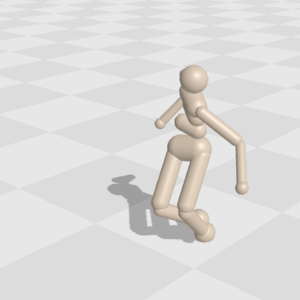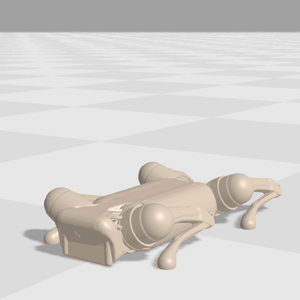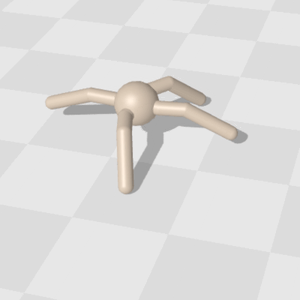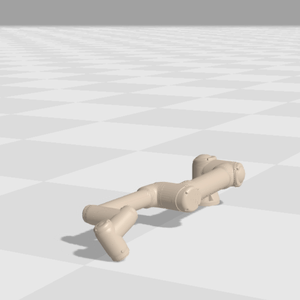A differentiable physics engine written in JAX.
Project description

Brax is a fast and fully differentiable physics engine used for research and development of robotics, human perception, materials science, reinforcement learning, and other simulation-heavy applications.
Brax is written in JAX and is designed for use on acceleration hardware. It is both efficient for single-device simulation, and scalable to massively parallel simulation on multiple devices, without the need for pesky datacenters.
Brax simulates environments at millions of physics steps per second on TPU, and includes a suite of learning algorithms that train agents in seconds to minutes:
- Baseline learning algorithms such as PPO, SAC, ARS, and evolutionary strategies.
- Learning algorithms that leverage the differentiability of the simulator, such as analytic policy gradients.
One API, Three Pipelines
Brax offers three distinct physics pipelines that are easy to swap:
- Generalized calculates motion in generalized coordinates using the same accurate robot dynamics algorithms as MuJoCo and TDS.
- Positional uses Position Based Dynamics, a fast but stable method of resolving joint and collision constraints.
- Spring provides fast and cheap simulation for rapid experimentation, using simple impulse-based methods often found in video games.
These pipelines share the same API and can run side-by-side within the same simulation. This makes Brax well suited for experiments in transfer learning and closing the gap between simulation and the real world.
Quickstart: Colab in the Cloud
Explore Brax easily and quickly through a series of colab notebooks:
- Brax Basics introduces the Brax API, and shows how to simulate basic physics primitives.
- Brax Training introduces the Brax v2 API, and shows how to train a policy with the generalized backend.
Using Brax Locally
To install Brax from pypi, install it with:
python3 -m venv env
source env/bin/activate
pip install --upgrade pip
pip install brax
You may also install from Conda or Mamba:
conda install -c conda-forge brax # s/conda/mamba for mamba
Alternatively, to install Brax from source, clone this repo, cd to it, and then:
python3 -m venv env
source env/bin/activate
pip install --upgrade pip
pip install -e .
To train a model:
learn
Training on NVidia GPU is supported, but you must first install CUDA, CuDNN, and JAX with GPU support.
Learn More
For a deep dive into Brax's design and performance characteristics, please see our paper, Brax -- A Differentiable Physics Engine for Large Scale Rigid Body Simulation , which appeared in the Datasets and Benchmarks Track at NeurIPS 2021.
Citing Brax
If you would like to reference Brax in a publication, please use:
@software{brax2021github,
author = {C. Daniel Freeman and Erik Frey and Anton Raichuk and Sertan Girgin and Igor Mordatch and Olivier Bachem},
title = {Brax - A Differentiable Physics Engine for Large Scale Rigid Body Simulation},
url = {http://github.com/google/brax},
version = {0.9.0},
year = {2021},
}
Acknowledgements
Brax has come a long way since its original publication. We offer gratitude and effusive praise to the following people:
- Manu Orsini and Nikola Momchev who provided a major refactor of Brax's training algorithms to make them more accessible and reusable.
- Erwin Coumans who has graciously offered advice and mentorship, and many useful references from Tiny Differentiable Simulator.
- Baruch Tabanpour, a colleague who helped launch brax v2 and overhauled the contact library.
- Shixiang Shane Gu and Hiroki Furuta, who contributed BIG-Gym and Braxlines, and a scene composer to Brax.
- Our awesome open source collaborators and contributors. Thank you!
Project details
Release history Release notifications | RSS feed
Download files
Download the file for your platform. If you're not sure which to choose, learn more about installing packages.

















